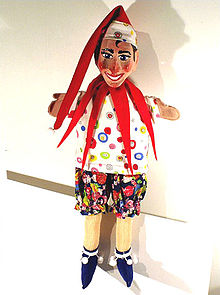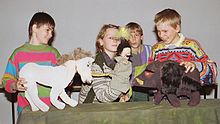Hand puppet
Hand puppets usually consist of a head, into which the index finger is stuck, and a dress, under which the whole hand disappears. The arms are usually stubby and are played with the thumb and little finger, hand puppets with legs are less common. With animal dolls , you hold the thumb and the other fingers so that the animal can open and close its mouth .
Hand puppetry as an art form
Traditional: Regardless of whether it is the “ Mister Punch ” in England, the character of Pulcinella from the Italian Commedia dell'arte or the Hanswurst, Kasper or Kasperl from the German-speaking area - the typical character traits of these well-known main characters are very similar: it is everywhere the pretty smart, humorous and funny little, simple man from the street, who is not squeamish and knows how to defend himself with an alert mind and sometimes with sophisticated cunning and thus shows the viewer how to get through reasonably well Life beats.
The figures around the " Punch " of the Punch and Judy Theater are mostly hand puppets - accordingly widely known. The classics are called Kasper, Seppel (his friend), Wachtmeister , Devil , Crocodile , Grandmother , Witch and Princess . Puppeteers usually make their hand puppets themselves or have them made individually by special sculptors - the most famous of them are probably Theo Eggink , Till de Kock , Fritz Herbert Bross and Jürgen Maaßen . The skillful handling of the hand puppet is often underestimated and requires patient guidance and a lot of practice. Famous artistic hand puppeteers included Max Jacob , Rudolf Fischer , Friedrich Arndt , Wolfgang Buresch , Therese Keller, Benita Steinmann, Gerd J. Pohl , Alfredo Bannenberg , Jo Micovich , Heinrich Maria Denneborg , Oswald Hempel , Heinz Fülfe , Paul Hölzig , Walter Büttner and Erhard Reis .
New development: Since the beginning of the 1970s, the German puppet theater scene has moved more and more away from puppet theater to free art forms. The main engines were Peter Steinmann (the stage) in Berlin, Marieluise Ritter (frankfurter figurentheater) in Frankfurt and Peter Röders (Fabula-Theater) in Kiel (now Idstedt). All banned hand puppets and dramaturgy from their pieces, but continued to use the hand puppet and soon added other figures to be played above the play bar - stick figures, dangling dolls (quirks) or figures with internal rotating mechanics (according to Hawlik), such as. B. the Wulle figure and the penguins of the Frankfurt puppet theater.
The simple construction not only means that hand puppets can also be made and played by amateurs and children. The greatest artistic attraction lies in the direct connection with the human hand. She is therefore the most physical type of figure, can move most spontaneously and thus react most directly to the audience. She breathes together with the puppeteer and, perfectly played, appears so natural that the viewer repeatedly succumbs to the illusion that she is really alive. Not to be forgotten are the countless ventriloquists of the western world, for the most part brilliant puppeteers who all work with hand puppets (especially snap-mouth figures). Only the magical liveliness of their dolls causes the necessary distraction from the face of the manipulator.
Friedrich Arndt dealt intensively with the artistic possibilities of expression of the hand puppet and published a small compendium of hand puppetry as early as 1950, which is still valid today. He once said: "Actually, the hand puppet is the most difficult type of character to play, but hardly anyone knows that, and unfortunately so many wonderful opportunities are being given away." He was quite the opposite and to the not mild horror of all of his generation's puppet theater colleagues , the Hohnstein puppet in person, enthusiastic about the young movement and staged three completely free-hand puppet theater plays in the Frankfurt puppet theater between 1974 and 78 with great commitment.
Hand puppets as toys and in educational use
Hand puppets as children's toys are available from specialist retailers in very different qualities.
Sock puppets are hand puppets made from stockings with scraps of wool and cardboard , which also move their mouths and make faces and, due to their very simple production method, can be made by older kindergarten children and elementary school students.
Outside of artistic use or as children's toys, they are sometimes mascots . Role plays can also provide valuable help in psychotherapy, particularly for younger and somewhat older people. An example of hand puppets used in elementary schools are Fara and Fu or the Quiesel .
Famous hand puppets
- The Hohnsteiner Kasper
- The goose Mimi from Am dam des
- Caesar the hare
- Kermit the Frog and Miss Piggy from the Muppet Show
- Lemmi from " Lemmi and the Schmöker "
- Plumpaquatsch the green Aquarius, very elaborate hand puppet
- Werner Momsen , snap-mouth hand puppet by the puppeteer Detlef Wutschik
- Mr. Socko, a sock with a face which is used by WWE wrestler Mick Foley for his finishing move Mandible Claw.
Hand puppets have also been featured in Chinese puppet theater since the Ming Dynasty .
Others
In the film Rumpe and Tuli (2010) two sock puppets with this name play the leading roles. In the tragic comedy The Beaver (2011) by Jodie Foster , a beaver hand puppet takes more and more control over the life of the protagonist , played by Mel Gibson .
literature
- Friedrich Arndt: Das Handpuppenspiel , Bärenreiter-Verlag, Kassel, 1st edition 1950, since then many other editions
- PK Steinmann: The theater figure at hand - basics and practice , Nold, Frankfurt / Main 2005, ISBN 978-3-935011-55-6
- Johannes Minuth : The puppet theater and its development history - From the bosom to the puppetry art , Nold, Frankfurt / Main 1996 ISBN 3-922220-75-4
- Jo Micovich : The 1x1 of the hand puppet show , Wuppertal 1977.
- Friedrich Arndt : The hand puppet show , Kassel 1965 (4th edition)
- Erhard Reis : The hand puppet , Opladen 1950.
- Gustav Schenk : A house book for puppet shows. Play school and games for hand puppets . Illustrations by Grethe Juergens . Langen, Berlin 1937.
- Ernst Lehmann: The hand puppet game , Potsdam 1934.
- Leo Weismantel : Workbook of the puppet shows , Frankfurt / Main 1924.


